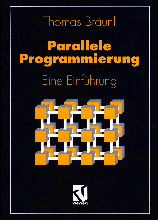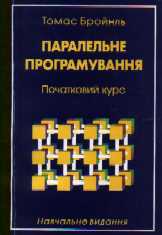


English version:
Prentice-Hall, Englewood Cliffs NJ, 1993, pp. (X, 270)
A teacher's manual with solutions to the
exercises is available from Prentice-Hall
Russian/Ukrainian edition: Vyschshaya Shkola Publishers,
Kiev, 1997, pp. (IX, 205)
German edition:
Vieweg Verlag, Wiesbaden 1993
Preface Part I Fundamentals 1. Introduction 2. Classifications 2.1 Computer System Classification 2.2 Levels of Parallelism 2.3 Parallel Operations 3. Petri Nets 3.1 Simple Petri Nets 3.2 Extended Petri Nets 3.3 Sample Petri Nets 4. Parallel Processing Concepts 4.1 Coroutines 4.2 Fork and Join 4.3 ParBegin and ParEnd 4.4 Processes 4.5 Remote Procedure Call 4.6 Implicit Parallelism 4.7 Explicit versus Implicit Parallelism 5. Network Structures 5.1 Bus Networks 5.2 Switching Networks 5.3 Point to Point Networks 5.4 Comparison of Networks Exercises I Part II Asynchronous Parallelism 6. Structure of a MIMD System 6.1 MIMD Computer Systems 6.2 Process States 7. Synchronization and Communication in MIMD Systems 7.1 Software Solution 7.2 Hardware Solution 7.3 Semaphores 7.4 Monitors 7.5 Message Passing and Remote Procedure Call 8. Problems with Asynchronous Parallelism 8.1 Inconsistent Data 8.2 Deadlocks 8.3 Load Balancing 9. MIMD Programming Languages 9.1 Concurrent Pascal 9.2 Communicating Sequential Processes CSP 9.3 occam 9.4 Ada 9.5 Sequent-C 9.6 Linda 9.7 Modula-P 10. Coarse-Grained Parallel Algorithms 10.1 Bounded Buffer with Semaphores 10.2 Bounded Buffer with a Monitor 10.3 Assignment Distribution via Monitor 10.4 Asynchronous Simulation Exercises II Part III Synchronous Parallelism 11. Structure of a SIMD System 11.1 SIMD Computer Systems 11.2 Data Parallelism 11.3 Virtual Processors 12. Communication in SIMD Systems 12.1 SIMD Data Exchange 12.2 Connection Structures of SIMD Systems 12.3 Vector Reduction 13. Problems with Synchronous Parallelism 13.1 Indexed Vector Operations 13.2 Mapping Virtual Processors onto Physical Processors 13.3 Bottlenecks from Peripheral Attachments 13.4 Network Bandwidth 13.5 Multi-User Operation and Fault Tolerance 14. SIMD Programming Languages 14.1 Fortran 90 14.2 C* 14.3 MasPar Programming Language 14.4 Parallaxis 15. Massively Parallel Algorithms 15.1 Numerical Integration 15.2 Cellular Automata 15.3 Prime Number Generation 15.4 Sorting 15.5 Systolic Matrix Multiplication 15.6 Generation of Fractals 15.7 Stereo Image Analysis Exercises III Part IV Other Models of Parallelism 16. Automatic Parallelization and Vectorization 16.1 Data Dependence 16.2 Vectorization of a Loop 16.3 Parallelization of a Loop 16.4 Solving Complex Data Dependences 17. Non-Procedural Parallel Programming Languages 17.1 *Lisp 17.2 FP 17.3 Concurrent Prolog 17.4 SQL 18. Performance of Parallel Systems 18.1 Speedup 18.2 Scaleup 18.3 MIMD versus SIMD 18.4 Validity of Performance Data Exercises IV References Index